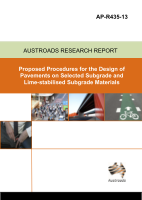Pavement

Proposed Procedures for the Design of Pavements on Selected Subgrade and Lime Stabilised Subgrade Materials
- Publication no: AP-R435-13
- ISBN: 978-1-925037-04-3
- Published: 13 May 2013
- PDF (free) Download
The report reviews current Australian and selected international structural design methods for pavements on lime-stabilised subgrade layers. Research to investigate in-service strength and modulus of lime-stabilised materials is also summarised. The report proposes design methods for inclusion in the Austroads Guide to Pavement Technology Part 2: Pavement Structural Design.It is anticipated that these draft procedures will be used by practitioners and revised as necessary for inclusion in the next edition of the Guide.
- 1. Introduction
- 1.1. Background
- 1.2. Scope
- 2. Review of Pavement Design Methods for Flexible Pavements which include Lime-stabilised Subgrade
- 2.1. Introduction
- 2.2. United States of America
- 2.2.1. AASHTO MEPDG
- 2.2.2. Texas Department of Transportation
- 2.2.3. Florida Department of Transportation
- 2.2.4. Illinois Department of Transportation
- 2.3. UK Design Method
- 2.4. French Design Method
- 2.5. Australian Design Methods
- 2.5.1. Queensland Department of Transport and Main Roads Design Methods
- 2.5.2. VicRoads Design Methods
- 2.5.3. Roads and Maritime Services NSW Design Methods
- 2.5.4. Department of Planning, Transport and Infrastructure South Australia
- 2.5.5. Main Roads Western Australia
- 3. Proposed Austroads Mechanistic Design Procedures
- 3.1. Introduction
- 3.2. Scope of Proposed Design Method
- 3.3. Maximum CBR and Modulus of Lime-stabilised Subgrade
- 3.3.1. Measure of Subgrade Support
- 3.3.2. Determination of Modulus from CBR
- 3.4. Variation in Modulus with Underlying Support
- 3.4.1. Current Characterisation of Selected Subgrade Materials
- 3.4.2. Proposed Characterisation of Lime-stabilised Subgrade Materials
- 3.5. Proposed Method
- 4. Proposed Austroads Empirical Design Method
- 4.1. Introduction
- 4.2. Proposed Guidance on use for Pavements with Selected Subgrade or Stabilised Subgrade Materials
- 5. Conclusions
- 5.1. General
- References
- Appendix A Revised Text Sections 5.1 and 5.3.8
- Appendix B Revised Text Section 8.2
- 8.2. Mechanistic Procedure
- Appendix C Revised Text of Section 8.3
- 8.3. Empirical Design of Granular Pavements with Thin Bituminous Surfacing
- Appendix D Revised Text of Section 12.8.2
- Determination of basic thickness
- Pavement composition
- Appendix E Revised Text of Appendix K of Part 2
- K.1 Example 1: Utilising Unbound Granular Materials
- K.2 Example 2: Utilising Crushed Rocks and Selected Subgrade Materials
- Step 1 Trial selected subgrade thickness
- Step 2 Design CBR of selected subgrade
- Step 3 Select granular material types and thicknesses
- Step 4 Check whether the total thickness of cover over in situ subgrade is adequate
- Step 5 Increase selected subgrade thickness and repeat steps 1 to 4
- K.3 Example 3: Utilising Crushed Rocks and Lime-stabilised Subgrade Materials
- Step 1 Trial stabilised subgrade thickness
- Step 2 Design CBR of stabilised subgrade
- Step 3 Select granular material types and thicknesses
- Step 4 Check whether the total thickness of cover over in situ subgrade is adequate
Related publications
Latest Pavement News
